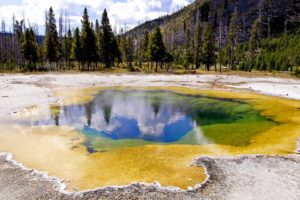 Research has led some scientists to believe that the supervolcano under Yellowstone National Park has the potential to erupt far sooner than previously believed, taking only decades instead of the expected centuries.
Research has led some scientists to believe that the supervolcano under Yellowstone National Park has the potential to erupt far sooner than previously believed, taking only decades instead of the expected centuries.
Don’t be too worried, though—just because it is possible does not mean that it is likely to happen. According to the U.S. Geological Survey, the chances of a major volcanic eruption in any given year is 1 in 730,000, which is about the same for an asteroid hitting the planet.
What we now know as Yellowstone National Park was created on top of a very geologically active area. The Yellowstone Caldera last had a major eruption about 630,000 years ago, in what is called the Lava Creek eruption; its last lava flow, meanwhile, occurred about 70,000 years ago. Since then, the area has remained geologically active—just look at Old Faithful, the famous geyser than spews forth water about once every hour or two—but until recently, scientists believed that the volcano would not be able to erupt again for at least a few centuries.
But according to some researchers from Arizona State University, the time frame seems to actually much shorter. By examining minerals in fossilized volcanic ash, they determined that it would only take a few decades for the volcano to become viable again.
“It’s shocking how little time is required to take a volcanic system from being quiet and sitting there to the edge of an eruption,” said one of the graduate students involved with the project, Hannah Shamloo.
Another factor is the underground chamber of magma that feeds the volcano. Scientists previously believed that it drained completely after each eruption, and would thus need a long period, possibly even centuries, to refill and become dangerous again. However, in 2013, James Farrell of the University of Utah determined that this reservoir was actually 2.5 times bigger than it we used to believe, which if true would make it about as full now as it was when it last erupted.
According to Farrell, “What we’re seeing now agrees with the geologic data that we have about past eruptions. And that means there’s the potential for the same type of eruption that we’ve seen in the past.”
“That’s not to say it’s getting any bigger,” he noted in an interview with National Geographic. “It’s just that our ability to see it is getting better.”











